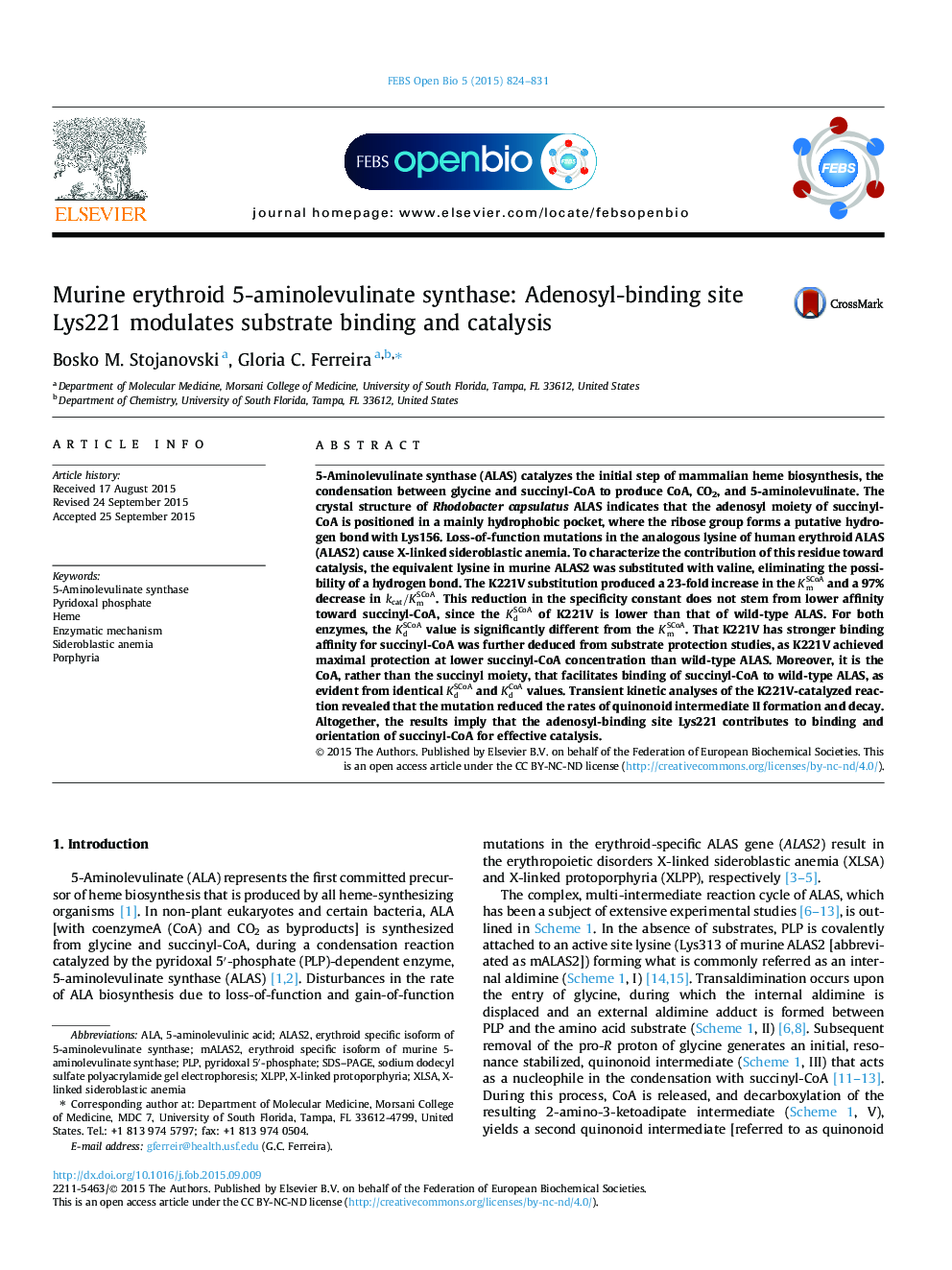| کد مقاله | کد نشریه | سال انتشار | مقاله انگلیسی | نسخه تمام متن |
|---|---|---|---|---|
| 1981649 | 1539419 | 2015 | 8 صفحه PDF | دانلود رایگان |
عنوان انگلیسی مقاله ISI
Murine erythroid 5-aminolevulinate synthase: Adenosyl-binding site Lys221 modulates substrate binding and catalysis
دانلود مقاله + سفارش ترجمه
دانلود مقاله ISI انگلیسی
رایگان برای ایرانیان
کلمات کلیدی
ALAPLPALAS2X-linked sideroblastic anemiaXLSA5-Aminolevulinate synthase - 5-آمینولولولین سنتاز5-Aminolevulinic acid - 5-آمینولولولینیک اسیدSDS–PAGE - SDS-PAGESodium dodecyl sulfate polyacrylamide gel electrophoresis - الکتروفورز ژل پلی اتیل آمید سدیم دودسیل سولفاتEnzymatic mechanism - مکانیزم آنزیمیHeme - هم Pyridoxal phosphate - پرییدکسال فسفاتPorphyria - پورفیریpyridoxal 5′-phosphate - پیریدوکسال 5'-فسفاتSideroblastic anemia - کم خونی Sideroblastic
موضوعات مرتبط
علوم زیستی و بیوفناوری
بیوشیمی، ژنتیک و زیست شناسی مولکولی
زیست شیمی
پیش نمایش صفحه اول مقاله

چکیده انگلیسی
5-Aminolevulinate synthase (ALAS) catalyzes the initial step of mammalian heme biosynthesis, the condensation between glycine and succinyl-CoA to produce CoA, CO2, and 5-aminolevulinate. The crystal structure of Rhodobacter capsulatus ALAS indicates that the adenosyl moiety of succinyl-CoA is positioned in a mainly hydrophobic pocket, where the ribose group forms a putative hydrogen bond with Lys156. Loss-of-function mutations in the analogous lysine of human erythroid ALAS (ALAS2) cause X-linked sideroblastic anemia. To characterize the contribution of this residue toward catalysis, the equivalent lysine in murine ALAS2 was substituted with valine, eliminating the possibility of a hydrogen bond. The K221V substitution produced a 23-fold increase in the KmSCoA and a 97% decrease in kcat/KmSCoA. This reduction in the specificity constant does not stem from lower affinity toward succinyl-CoA, since the KdSCoA of K221V is lower than that of wild-type ALAS. For both enzymes, the KdSCoA value is significantly different from the KmSCoA. That K221V has stronger binding affinity for succinyl-CoA was further deduced from substrate protection studies, as K221V achieved maximal protection at lower succinyl-CoA concentration than wild-type ALAS. Moreover, it is the CoA, rather than the succinyl moiety, that facilitates binding of succinyl-CoA to wild-type ALAS, as evident from identical KdSCoA and KdCoA values. Transient kinetic analyses of the K221V-catalyzed reaction revealed that the mutation reduced the rates of quinonoid intermediate II formation and decay. Altogether, the results imply that the adenosyl-binding site Lys221 contributes to binding and orientation of succinyl-CoA for effective catalysis.
ناشر
Database: Elsevier - ScienceDirect (ساینس دایرکت)
Journal: FEBS Open Bio - Volume 5, 2015, Pages 824-831
Journal: FEBS Open Bio - Volume 5, 2015, Pages 824-831
نویسندگان
Bosko M. Stojanovski, Gloria C. Ferreira,